No wonder that Formatville's motto is:
"Live by its 10 commandments or" - like Donnie Brasco would say - "Fuhgeddaboudit"
So if you want YOUR screenplay to be read and not tossed, apply these script formatting guidelines. Today the fourth commandment.

We asked our screenplay format expert, Matt, aka Formatman, to lead us through the 10 formatting commandments.
If you missed the introduction to this series of articles, you may want to check it out first.
Here is the link to Part 1, where it all started.
Formatman:
In this article illustrated with 21 screenplays, you'll discover how to use sounds effectively and write them with an accurate screenplay format. You will find out:
![]() the power of sounds
the power of sounds
![]() 3 ways to use sounds to enhance your screenplay
3 ways to use sounds to enhance your screenplay
![]() a Quiz to practice a powerful sound technique
a Quiz to practice a powerful sound technique
![]() essential screenplay format guidelines
essential screenplay format guidelines
![]() the screenplay format of special situations
the screenplay format of special situations
![]() and the answer to a puzzling screenwriting koan.
and the answer to a puzzling screenwriting koan.
Whatascript:
Why dedicating a whole Screenplay Format Commandment to Sounds?
Formatman:
Because sounds - and by sounds I mean every sound, including music and even the sound of silence - sounds play an important role in bringing your story to life.

The same way your descriptions can create powerful pictures in the mind of the Reader, using sounds skillfully may make a significant difference in having the Reader experience your descriptions.
Why?
Because the more senses you can trigger - and hearing is one of them - the more impactful your descriptions will be. And the more the Reader will be living your story.
So before looking at the screenplay format of sounds, let's first discover ...
There are many results you can achieve with sounds.
I will highlight the main three:
How to do that? Use sound effects.
This allows you to add sounds to the pictures you describe.
The result? A more impactful description.
Check out how Oliver Stone does it in Midnight Express:
We MOVE to HANDS, TIGHT - drawing out a strip of adhesive tape, SCISSORS move in TIGHT...SNIP! 
Did you notice how the sound effect "SNIP" enhanced your experience of the scene?
Here is the scene again, this time without the sound effect:
We MOVE to HANDS, TIGHT - drawing out a strip of adhesive tape, SCISSORS move in TIGHT...
Quite a difference, right?
As you can see, this is a very powerful technique.
And many produced screenwriters use it.It takes of course practice to use it skillfully. And that's why I created ....
"Draw me a sheep!"
This is one of the famous quotes from "The Little Prince", written by Saint Exupery.
Well, I adapted this quote to fit this Quiz. And it became ...
"Write me a sound!"
And I used the screenplays of produced screenwriters as examples.
This is how the Quiz goes. Just:
A. Read the instruction.
B. Guess how the screenwriter wrote this sound and
C. Click on the + sign to find out if you were in the ballpark.
By the way, observe the screenplay format of the sounds mentioned in this Quiz, as I will refer to it later on.
I started with easy sounds and increased the difficulty to challenge you. Ready? Here we go.
1. Harry Potter and The Half Blood Prince, screenplay written by Steve Kloves
Write me a sound! The sound of ... thunder.

DARKNESS. THUNDER -- or something like it -- sounds in the distance. BOOM. Then again. BOOM.
2. Shame - screenplay written by Steve McQueen and Abi Morgan
Write me a sound! The sound of ... an alarm clock.
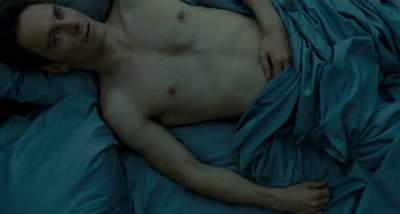
INT. BEDROOM. APARTMENT. DAWN. BRANDON SULLIVAN [early 30's] lies staring up caught in a disarray of sheets until- The PEEP PEEP PEEP of an alarm clock, from deep within a distant apartment. 3. The Bourne Identity, screenplay written by Tony Gilroy and W. Blake Herron
Write me a sound! The sound of ... a pager pulsing.
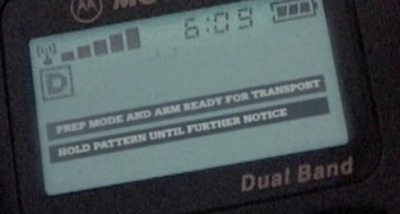
And then, HIS E-PHONE PAGER starts pulsing -- hum -- hum --
4. It‘s Kind of a Funny Story, screenplay written by Ryan Fleck & Anna Boden
Write me a sound! The sound of ... a beating heart.
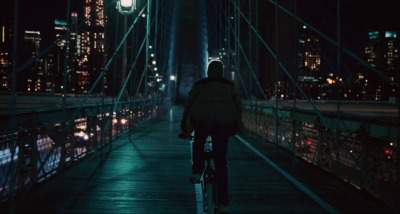
EXT. BROOKLYN STREET - NIGHT CRAIG GILNER (16, handsome, but awkward) glides on his bike toward the Brooklyn Bridge. He is the only one on the streets. A rhythmic beating heart is the only sound we hear. BADOOM BADOOM BADOOM The heartbeat increases in pace as Craig nears the bridge.
5. Ali, screenplay written by Stephen J Rivele & C. Wilkinson and Eric Roth & Michael Mann
Write me a sound! The sound of ... a blow.
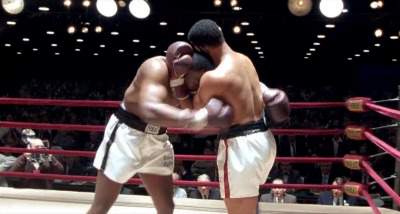
INT. RING - ROUND FIVE - LISTON rushes Clay. He knows this is his chance. Cassius tries to tie Liston up by holding onto the back of his neck, but Liston pounds left and right hooks. If anybody wondered if Clay could take punishment, this answers that. WHAM-WHAM- WHAM-WHAM-WHAM...five huge hooks.
6. The Bourne Identity, screenplay written by Tony Gilroy and W. Blake Herron
Write me a sound! The sound of ... a bullet fragment falling into a jar.

GIANCARLO playing doctor in a greasy kitchen apron. Cutting away the clothes. Turning THE MAN on his side. Two bullet wounds in the back. Probing them, judging them. Now -- GIANCARLO with a flashlight in his teeth -- TINK -- TINK -- TINK -- bullet fragments falling into a washed-out olive jar.
7. Prisoners, screenplay written by Aaron Guzikowski
Write me a sound! The sound of ... squeezing the trigger of a rifle.
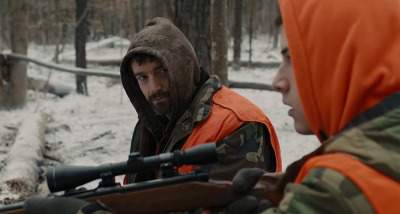
RALPH Dover, 15, aims his rifle, a little shaky, still learning. He squeezes the trigger -- POP POP --
8. Blow, screenplay written by David McKenna and Nick Cassavetes
Write me a sound! The sound of ... workers swinging long steel machetes.

EXT. GUARJIRA, COLOMBIA - 1989 - DAY A majestic panorama of the lush green slopes that are the Columbian highlands. A faint chopping sound IS HEARD and then another. WHOOSH. WHOOSH. The view changes and tiny dots appear on the hillside vegetation. WHOOSH. CLOSER We realize the dots are people. Workers swinging long steel machetes in slow methodical rhythm. WHOOSH. WHOOSH.
9. The Bourne Identity, screenplay written by Tony Gilroy and W. Blake Herron
Write me a sound! The sound of ... a screaming security alarm.
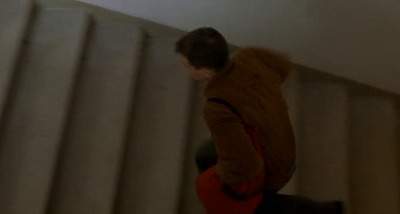
INT. U.S. CONSULATE BACK STAIRWAY -- DAY BOURNE climbing fast -- two -- three -- stairs at a time -- racing up as a SECURITY ALARM STARTS SCREAMING -- bleet -- bleet -- bleet --
Did you guess right? Good for you.
A word of caution:
Do NOT use sound effects just because you can. Keep in mind that EACH sound effect you include in your descriptions should enhance the overall experience of the Reader.
If you don't do that - and that's the case even if your screenplay format is accurate - your screenplay will end up being a comic book and you will break the Third Commandment of Screenplay Format.
By the way if you like Quizzes, I will reveal the answer to a very puzzling Screenwriting Koan at the end of this article. Check it out.
This is the second main result you can create with sounds.
Let's go back to the opening scene from Shame, screenplay written by Steve McQueen and Abi Morgan as it illustrates this effect perfectly.
The scene is full of sounds and these sounds leave you with the ordinariness of the protagonist environment.
They could have achieved this result with a short series of shots, which would have been the obvious solution. They didn't. They opted for an economy of pictures and used sounds instead, making the scene more impactful, as we can all relate to the sounds described.
By the way, keep noticing the screenplay format while reading, as it will make it easier for you later on when I go through the screenplay formatting guidelines.
INT. BEDROOM. APARTMENT. DAWN. BRANDON SULLIVAN [early 30's] lies staring up caught in a disarray of sheets until- The PEEP PEEP PEEP of an alarm clock, from deep within a distant apartment. The MUFFLED PAD of FOOTSTEPS crossing overhead- BRANDON listens then gets up, pulls blinds and heads out towards the bathroom- The SOUND of his feet disappearing down a distant corridor. The MURMUR of an answer phone as we hear BRANDON peeing, in a far off bathroom.
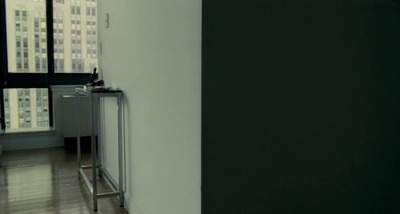
This is another example of creating an ambience, a mood. This time it is from Bad Lieutenant written by Abel Ferrara and Zoe Lund.
By putting together a collection of familiar sounds, they created a peaceful atmosphere of their protagonist's neighborhood:
The MORNING SOUNDS Of FAMILY BICKERING, LAWN MOWERS, and SHOUTED GOOD-BYES are heard coming from many HOUSES on this close-knit block. A NEW BABY can be heard BAWLING inside LT'S HOUSE.
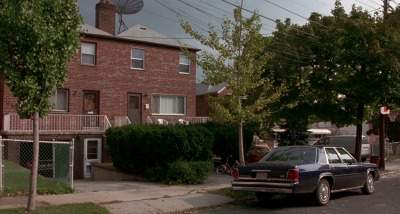
Peter Shaffer uses the sound of music to reinforce the contrast between two scenes in his screenplay Amadeus:
Both servants run at the door frantically - once, twice, three times - and the frail lock gives. The door flies open. Immediately, the stormy, frenzied opening of Mozart's Symphony No. 25 (the Little G Minor) begins. We see what the servants see. INT. OLD SALIERI'S SALON - NIGHT Old Salieri lies on the floor in a pool of blood, an open razor in his hand. He has cut his throat but is still alive...INT. BALLROOM - NIGHT Twenty-five dancing couples, fifty guests, ten servants, full orchestra. As the music slows a little, we see a Masquerade Ball in progress. A crowded room of dancers is executing the slow portion of a dance fashionable in the early 1820's. EXT. STREET OUTSIDE SALIERI'S HOUSE - NIGHT As the fast music returns, we see Old Salieri being carried out of his house on a stretcher by two attendants...
For another example of contrast, this time from It‘ss Kind of a Funny Story, click this link.
Now that you got the difference that sounds can make to your screenplay, let's have a look at a few guidelines in terms of screenplay format.
Although the trend is changing and it no more compulsory anymore to CAP important sounds, most screenwriters still do it.
Just don't be surprised if the screenplay format of some screenplays you read does not include any capped sounds anymore.
Generally speaking the following 2 screenplay formatting rules apply to determine if a sound should be capped:
Imagine a scene where we see a dog barking or a neighbor knocking at the door.
In this case, since we see the dog or the neighbor making the sound of barking or knocking, both are considered ON SCREEN or VISIBLY CLEAR and the sound does NOT get capped.
This is an example from No Country For Old Men from the Coen Brothers
CHIGURH I need you to step out of the car, sir. The man opens the door and emerges. MAN Am I...? Chigurh reaches up the man's forehead with the end of the tube connected to the air tank.CHIGURH Would you hold still please, sir. A hard pneumatic sound. The man flops back against the car. Blood tickles from a hole in the middle of his forehead.
Since we see Chigurh with his apparatus, the hard pneumatic sound is ON SCREEN or VISIBLY CLEAR in terms of screenplay format and does NOT get capped
This is another example. This time from The Bourne Supremacy - screenplay written by Tony Gilroy:
Bourne goes to the front door finds "Sewell and Marbury" and rings the bell. No answer.
There is No CAP for RINGS or BELL, as we see the bell. .
The other way around applies when the sound is OFF SCREEN or NOT VISIBLY CLEAR. We then CAP the sound.
This is an example from I Know What You Did Last Summer", screenplay written by Kevin Williamson
INT. STAGE - LATER MC And this year's Croaker Queen is...The final contestants stand in frenzied anticipation as the MC opens the envelope. MC MISS HELEN SHIVERS! THUNDEROUS APPLAUSE fills the town hall.
This is another example from The Bourne Supremacy:
A beat -- long unbroken. BOURNE What are you doing here? NICKY I was posted here after Berlin. BOURNE Where's Daniels? The office PHONE goes.
In this case we don't see the phone when it rings. Therefore it is CAPPED.
If the sound is NOT vital to the scene and is basically just a background noise - e.g. a TV, a radio, cars in the street - the screenplay format is NOT to CAP the sound.
This is again an example from Shame:
INT. CORRIDOR. APARTMENT. DAWN. The answer machine message drowned by the flushing of the toilet, the shutting of the door and the shower being switched on.
However, if the sound affects the scene, the screenplay format is then to CAP the sound.
This is an example from Constantine screenplay written by Kevin Brodbin and Frank A. Cappello
INT. PRISON FOR THE CRIMINALLY INSANE Corridor of ancient stone and steel extends into infinite darkness. Stale air hangs in the dim half-light like atomized ether. There is WHISPERING. And tangled VOICES.
You have determined that a particular sound is important to the narrative. Now, what?
The next step in terms of screenplay format is for you to determine which word(s) you want to CAP.
Depending on the experience you want to leave the Reader with, you may want to emphasize - and therefore CAP:
1. The source of the sound (e.g. THE GUN) or2. The number of sounds heard (e.g. TWO SHOTS) or
3. The effect of the sound (e.g. the car SHATTERS the door of the phone booth) or
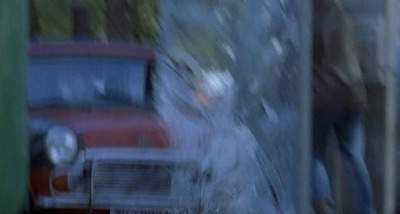
4. A combination of above
You have now decided which aspect(s) of the sound you want to cap.
The next step in terms of screenplay format is to determine the importance of the sound.
Two cases:
Look again at the above mentioned examples of Constantine and I Know What You Did Last Summer to see the application of this screenplay format guideline.
This is an example of I Am Number Four, screenplay written by Alfred Gough & Miles Millar and Marti Noxon using such a secondary scene heading
EXT. JUNGLE - NIGHT The Teen's naked feet pound the hot, wet earth as he sprints through the maze of trees. Flecks of moonlight ricochet off the crystal pendant that dangles around his neck. He moves impossibly fast. Faster than any human could.A MONSTROUS HOWL ECHOES as something otherworldly catches his scent and begins thrashing in pursuit. The Teen's face tightens with dread and the SHOUTS of his pursuers hammer his ears.
The best way to test drive your screenplay format is to look at how your page looks like.
Two things to keep in mind:
I just covered the general screenplay format guidelines dealing with sounds.
Now is the time to look at special cases, like:
Music can be a way to reveal important information about a character or a place and can create a mood or atmosphere.
Generally speaking – and for legal reasons - do not mention a particular music in your screenplay unless:
1. this piece of music is essential to the story,
2. you own the rights to the music or these rights are now in the public domain.
Indicate the music genre instead (e.g. ROCK, COUNTRY MUSIC, CLASSICAL MUSIC). The director / composer will take care of finding a fitting piece of music.
This is an example from Jackie Brown, screenplay written by Quentin Tarantino
INT. LOS ANGELES INTERNATIONAL AIRPORT - DAY We hear the rhythm of funky seventies SOUL MUSIC.
If needed, add a description. This is what Harmony Korine did in her screenplay Kids:
As soon as the scene ends, so does the sound of the two having sex. Very fast, very hard-paced music accompanies the credits. The music should be strong enough to maintain the intensity of the scene, Hard-core, Punk.
If a particular piece of music is however required for the story, name the title of the music, like Peter Schaffer did in his screenplay Amadeus:
The stormy, frenzied opening of Mozart's Symphony No. 25 (the Little G Minor) begins.
This is another example, this time from Almost Famous from Cameron Crowe:
INT. BEDROOOM -- NIGHT William locks the door. He reaches under his bed. It's a black leatherette travel bag, with tartan design. He unzips the bag -- it's filled with albums. He flips through the amazing, subversive cache of music. Cream's Wheels of Fire... the seminal Bob Dylan bootleg Great White Wonder... the Rolling Stones' Get Yer Ya Ya's Out... The Beach Boys' Pet Sounds... Abraxas by Santana... Jethro Tull's Stand Up... The Mother's of Invention's We're Only In It For The Money... Led Zeppelin... Crosby, Stills and Nash... Miles Davis' Bitches Brew... and The Who's Tommy...
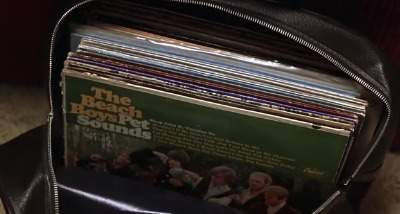
If you want to include in your screenplay your own song, or a song you imagine for the purpose of your story, then the screenplay format will be the one of a dialogue.
The only - and critical - difference in terms of screenplay format is that you will write each line of the song separately – even if it is less or more than the number of characters that is normally on a dialogue line.
The idea behind this screenplay format practice is to give the reader the experience of the song.
This is an example from The Talented Mr. Ripley, screenplay written by Anthony Minghella:
EXT. CENTRAL PARK WEST TERRACE. EARLY EVENING. Ripley is at the piano, accompanying FRAN, a young soprano. FRAN (SINGS) Ah, such fleeting paradise such innocent delight to love, be loved, a lullabye, then silence.
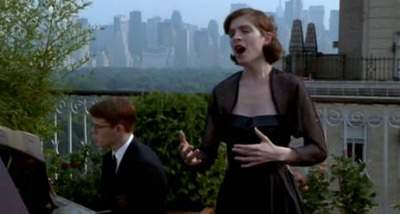
As you can see the screenwriter did not respect the standard screenplay format of a dialogue. If he had done that, it would have looked as follows:
Ah, such fleeting paradise such innocent delight to love, be loved, a lullabye, then silence.
and the reader would not have had the experience of the song.
This will sound very paradoxal but you can use silence as a "sound".
In the opening scene of It‘s Kind of a Funny Story, Ryan Fleck & Anna Boden combine the 3 main results you can achieve with sounds as mentioned above and contrasts the accelerating sound effect of a heart beating with a sudden silence.
EXT. BROOKLYN STREET - NIGHT CRAIG GILNER (16, handsome, but awkward) glides on his bike toward the Brooklyn Bridge. He is the only one on the streets. A rhythmic beating heart is the only sound we hear. BADOOM BADOOM BADOOM The heartbeat increases in pace as Craig nears the bridge. EXT. BROOKLYN BRIDGE PEDESTRIAN PATH We float behind Craig as he approaches the bridge’s first tower. Craig is still the only person there. BADOOM BADOOM BADOOM He arrives at the tower, steps off his bike, and looks out over the East River. BADOOM BADOOM BADOOM He climbs up onto a steel girder. Walks to the edge, over the speeding traffic below, then out over the water. BADOOMBADOOMBADOOMBADOOMSILENCE... LYNN (O.S.) Craig!? Craig looks behind him to find his mother
Again notice the screenplay format of the sound effect (BADOOM) and of SILENCE. Both have been CAPPED and are used as a secondary scene heading, as they impact the scene.
This is another example of using silence as contrast. It comes from The Virgin Suicides, written by Sophie Coppola.
NARRATOR (MAN'S VOICE) Cecilia was the first to go. CLOSE ON CECILIA IN SILENCE the still body of a 13-year-old girl floats in pink bath water. She stares past us.CECILIA'S POV: Two PARAMEDICS (one fat, one tall and skinny with a Wyatt Earp mustache) look down at her, mesmerized and frightened by her tranquility. Suddenly we HEAR a woman's SCREAM -- the silence is interrupted as her mother, MRS. LISBON, lunges into the bathroom, reinstating the reality (and sounds) of the room.
There are different ways to write silent scenes in terms of screenplay format.
This is the great advice given by the screenwriter John August on his blog:
Look at your silent scenes from your reader’s perspective, and try to read them without knowing what’s happening next. You’re not nearly as curious what it sounds like as what it feels like to have the sound missing. Write that.
Arguments have specific sounds. Usually loud voices, followed by deadly silences.
In the same way there are specific dialogue techniques you will use to write an argument, like list, trigger, repetition and putting down to name a few, there is also a specific screenplay format to use for interruptions and - by extension - arguments.
If two people react / speak at the same time, the screenplay format will be as follows:
JIM AND JO (simultaneously) What?
or
JIM What did you say? JO (overlapping) What did you say?
or you write the dialogue next to each other:
JIM JO What? What?
This is a great scene of a family dinner and its related argument. It comes from August: Osage County screenplay written by Tracy Letts.
Little Charles goes to put Mattie Fae's casserole on the table, but drops it. It lands on the floor with a sickening SPLAT.LITTLE CHARLES (CONT'D) BILL Oh Jesus --! Whoops. MATTIE FAE STEVE Goddamn it --! O-pah! MATTIE FAE You goddamn clumsy goofball! LITTLE CHARLES CHARLIE Mom, I'm so sorry -- All right, nobody's hurt. Little Charles helps Johnna clean up the mess. MATTIE FAE (CONT'D) What about me? I'm hurt. CHARLIE LITTLE CHARLES You're not hurt. Mom, Jesus, I'm sorry -- IVY It's just an accident. MATTIE FAE That's my casserole! CHARLIE STEVE Let it go, Mattie Fae. It's not a party until someone spills something. CHARLIE Jean, you didn't get any chicken. BARBARA JEAN No, she won't -- I don't eat meat. CHARLIE STEVE You don't eat meat. Good for you. CHARLIE (CONT'D) "Don't eat meat." Okay. Who wants chicken? Little Charles, chicken? MATTIE FAE Just put it on his plate for him or he's liable to burn the house down.
A screenplay starts in most cases with a defining picture.
In some cases, you may however choose to start with a defining sound, to create a special effect.
The key to it is that it must be justified. There must be a pay-off in using this technique.
This is an example from Kill Bill, screeenplay written by Quentin Tarantino.
Notice the screenplay format OVER BLACK and WE STAY ON BLACK written as secondary scene headings.
OVER BLACK We hear labored breathing. BLACK FRAME QUOTE APPEARS:QUOTE FADES OUT WE STAY ON BLACK ...breathing continues... Then a MAN'S VOICE talks over the breathing; MAN'S VOICE (O.S.) Do you find me sadistic? CUT TO: BLACK AND WHITE CU of a WOMAN lying on the floor, looking up. The woman on the floor has just taken a severe spaghetti-western-style gang beating. Her face is bloody, beaten up, and torn. The high contrast B/W turning the red blood into black blood.
This is another example. This time from Air Force One screenplay written by Andrew W. Marlowe.
Notice the screenplay format and the skillful use of the various techniques covered in this article (e.g. sound before picture, sound effect and sounds).
FADE TO BLACK The SOUNDS of a dinner banquet. Forks clanking against plates and the din of a hundred conversations, broken by... The DING, DING, DING of a SPOON tapping against a wine glass. SUPER TITLE: "MOSCOW - THREE WEEKS LATER FADE IN: INT. BANQUET ROOM - NIGHT Hundreds of men and women in formal evening wear sit at round banquet tables. A HUSH falls over the guests as the DINGING continues. All attention turns to the front table.
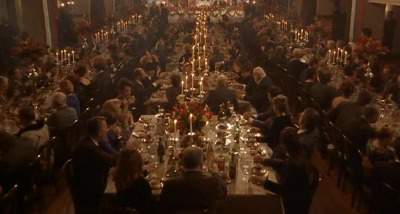
There is this famous Zen koan which goes, "What is the sound of one hand clapping?"
I take advantage of this article about sounds to reveal the answer to a very puzzling Screenwriting Koan:
What is the sound of a screenwriter announcing his latest screenplay to the world?
This is the answer.
Whatascript:
This concludes our interview on this fourth formatting commandment "Thou Shalt Use Sounds Effectively".
Thank you, Formatman.
Formatman:
* Hancock - screenplay written by Vincent Ngo and Vince Gilligan
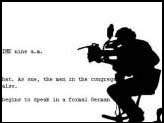
How to put the focus on sub location, characters, objects and time without directing? Use skillfully secondary scene headings.
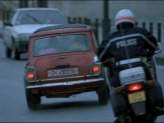
It's all about car scenes and how to write them (e.g. inside, outside, INT./EXT., in motion) And it includes a Top 6 Common Car actions.
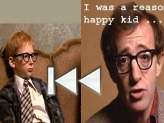
It's all about flashback. The controversy around it, 7 key components to make it effective, when to use it, and how to test ride it.
Pictures and screenplay extracts:
-- "It‘s Kind of a Funny Story", Keir Gilchrist (Craig), Anna Boden and Ryan Fleck (directors and screenwriters), Andrij Parekh (director of photography)
-- "Midnight Express" Oliver Stone (screenplay)
-- "Harry Potter and The Half Blood Prince, Steve Kloves (screenplay)
-- "Shame", Michael Fassbender (Brandon), Steve McQueen (director), Sean Bobbitt (director of photography), Steve McQueen and Abi Morgan (screenplay)
-- "The Bourne Identity", Doug Liman (director), Oliver Wood (director of photography), Matt Damon (Bourne), Tony Gilroy and W. Blake Herron (screenplay)
--"The Bourne Supremacy, Tony Gilroy (screenplay)
-- Ali, Michael Mann (director), Will Smith (Ali), Emmanuel Lubezki (director of photography), Stephen J Rivele & C. Wilkinson and Eric Roth & Michael Mann (screenplay)
-- "Prisoners", Hugh Jackman, Dylan Minnette; Denis Villeneuve (director), Roger Deakins (director of photography), Aaron Guzikowski (screenplay)
-- "Blow", David McKenna and Nick Cassavetes (screenplay)
-- "Bad Lieutenant", Abel Ferrara, Zoe Lund (screenplay)
-- "Amadeus", F. Murray Abraham (Salieri), Milos Forman (director), Miroslav Ondrícek (director of photography), Peter Shaffer (screenplay)
-- "No Country For Old Men", Ethan Coen & Joel Coen (direction and screenplay), Roger Deakins (director of photography)
-- "I Know What You Did Last Summer", J. Don Ferguson (MC); Jim Gillespie (director), Denis Crossan (director of photography), Kevin Williamson (screenplay)
-- "Constantine", Kevin Brodbin and Frank A. Cappello (screenplay)
-- "I Am Number Four", D.J. Caruso (director), Guillermo Navarro (director of photography), Alfred Gough & Miles Millar and Marti Noxon (screenplay)
-- "Jackie Brown", Quentin Tarantino (screenplay)
-- "Almost Famous", Cameron Crowe (screenplay)
-- "The Talented Mr. Ripley", Matt Damon (Ripley), Gretchen Egolf (Fran); Anthony Minghella (direction and screenplay), John Seale (director of photography)
-- "The Virgin Suicides", Hanna Hall (Cecilia), Sofia Coppola (direction and screenplay), Edward Lachman (director of photography)
-- "August: Osage County", Tracy Letts (screenplay)
-- "Kill Bill", Quentin Tarentino (screenplay)
-- "Air Force One", Wolfgang Petersen (director), Michael Ballhaus (director of photography), Andrew W. Marlowe (screenplay)
Go from Screenplay Format to Whatascript! Home page
* The Godfather (2), screenplay written by Francis Ford Coppola & Mario Puzo